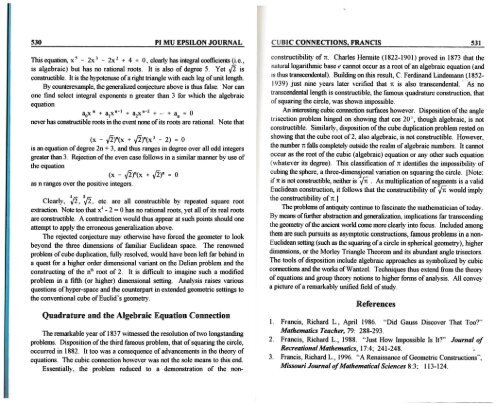Vol. 10 No 7 - Pi Mu Epsilon
Vol. 10 No 7 - Pi Mu Epsilon
Vol. 10 No 7 - Pi Mu Epsilon
Create successful ePaper yourself
Turn your PDF publications into a flip-book with our unique Google optimized e-Paper software.
530 PI MU EPSILON JOURNAL<br />
This equatiQl\ x ~ - 2x 3 - 2x 2 + 4 = 0, clearly has integral coefficients (i.e.,<br />
is algebraic) but has no rational roots. It is also of degree 5. Yet /i is<br />
constructible. It is the hypotenuse of a right triangle Vti.th each leg of unit length.<br />
By counterexample, the generalized conjecture above is thus false. <strong>No</strong>r can<br />
one find select integral exponents n greater than 3 for which the algebraic<br />
equation<br />
n n-1 n-2<br />
a O<br />
0<br />
x + a 1<br />
x + a 2<br />
x + ... + an =<br />
never has constructible roots in the event none of its roots are rational. <strong>No</strong>te that<br />
(x - /i)n(x + {i)n(x 3 - 2) = 0<br />
is an equation of degree 2n + 3, and thus ranges in degree over all odd integers<br />
greater than 3. Rejection of the even case follows in a similar manner bv use of<br />
~~~ .<br />
(x - {i) 0 (X + {i)n = 0<br />
as n ranges over the positive integers.<br />
4 8<br />
Clearly, f., "{i, etc. are all constructible by repeated square root<br />
extraction <strong>No</strong>te too that x 4 - 2 = 0 has no rational roots, yet all of its real roots<br />
are constructible. A contradiction would thus appear at such points should one<br />
attempt to apply the erroneous generalization above.<br />
The rejected cof\iecture may otherwise have forced the geometer to look<br />
beyond the three dimensions of familiar Euclidean space. The renowned<br />
problem of cube duplication, fully resolved, would have been left far behind in<br />
a quest for a higher order dimensional variant on the Delian problem and the<br />
constructing of the nth root of 2. It is difficult to imagine such a modified<br />
problem in a fifth (or higher) dimensional setting. Analysis raises various<br />
questions of hyper-space and the counterpart in extended geometric settings to<br />
the conventional cube of Euclid's geometry.<br />
Quadrature and the Algebraic Equation Connection<br />
The remarkable year of 183 7 witnessed the resolution of two longstanding<br />
problems. Disposition of the third famous problem, that of squaring the circle,<br />
occurred in 1882. It too was a consequence of advancements in the theory of<br />
equations. The cubic connection however was not the sole means to this end.<br />
Essentially. the problem reduced to a demonstration of the non-<br />
CUBIC CONNECTIONS, FRANCIS 531<br />
constructibility of 1t. Charles Hermite (1822-190 l) proyed in 1873 that the<br />
natural logarithmic base e cannot occur as a root of an algebraic equation (and<br />
is thus transcendental). Building on this result, C. Ferdinand Lindemann (1852-<br />
1939) just nine years later verified that 1t is also transcendental. · As no<br />
transcendental length is constructible, the famous quadrature construction. that<br />
of squaring the circle, was shown impossible.<br />
An interesting cubic connection surfaces however. Disposition of the angle<br />
trisection problem hinged on sho,ving that cos 20°, though algebraic, is not<br />
constructible. Similarly, disposition of the cube duplication problem rested on<br />
shoVti.ng that the cube root of2, also algebraic, is not constructible. However,<br />
the number 1t falls completely outside the realm of algebraic numbers. It cannot<br />
occur as the root of the cubic (algebraic) equation or any other such equation<br />
(whatever its degree). This classification of 1t identifies the impossibility of<br />
cubing the sphere, a three-dimensional variation on squaring the circle. [<strong>No</strong>te:<br />
if 1t i~ not constructib.le, n~ither is ~ . As multiplication of se~ents is a valid<br />
Euclidean construction, Jt follows that the constructibility of {i would imply<br />
the constructibility of 1t.)<br />
The problems of antiquity continue to fascinate the mathematician of today.<br />
By means of further abstraction and generalization. implications far transcending<br />
the geometry of the ancient world come more clearly into focus. Included among<br />
them are such pursuits as asymptotic constructions, famous problems in a non<br />
Euclidean setting (such as the squaring of a circle in spherical geometry), higher<br />
dimensions, or the Morley Triangle Theorem and its abundant angle trisectors.<br />
The tools of disposition include algebraic approaches as symbolized by cubic<br />
connections and the works ofWantzel. Techniques thus extend from the theory<br />
of equations and group theory notions to higher forms of analysis. All convev<br />
a picture of a remarkably unified field of study. -<br />
References<br />
1. Francis, Richard L., April 1986. '"Did Gauss Discover That Too''<br />
Mathematics Te4cher, 79: 288-293.<br />
2. Francis, Richard L., 1988. ""Just How Impossible Is It'' Journal of<br />
Recreational Mathematics, 17:4~ 241-248. :..<br />
3. Francis, Richard L., 1996. '"A Renaissance of Geometric Constructions'"<br />
Missouri Journal of Mathematical Sciences 8:3~ 113-124. '
















